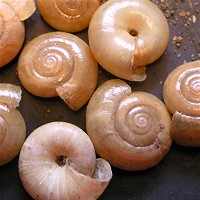Improving the reliability of amino acid geochronology
Description
The importance of a robust chronology for Quaternary sediments cannot be underestimated.
In recent years advances have been made in Amino Acid Racemization (AAR; Penkman, 2005), combining the isolation of an 'intra-crystalline' fraction of amino acids by exhaustive bleach treatment of ground shell carbonate (Sykes et al., 1995) with a new Reverse-Phase High Pressure Liquid Chromatography (RP-HPLC) method (Kaufman & Manley, 1998).
This combination of techniques results in the analysis of D/L values of multiple amino acids from the chemically-protected protein within the biomineral, enabling both decreased sample sizes and increased reliability. The intra-crystalline protein occurs within a 'closed system' during the burial history of the shell, vital for the application of this technique for geochronological purposes. Amino acid data obtained from the intra-crystalline fraction of calcitic biominerals indicate this to be a particularly robust repository for the original protein, with this coherent system maintained as far back as the Pliocene.
Details
Project members
- Kirsty Penkman
- Matthew Collins
Project dates
- 2005-2008
Funding bodies
- NERC
- English Heritage ALSF (Aggregates Levy Sustainability Fund)
- Wellcome Trust
Objectives
We aim to develop amino-acid racemization (AAR) as a dating tool by:
- using laboratory methods and computational chemistry to:
- establish a closed chemical system
- test non-linear models of decomposition kinetics
- develop methods of internal validation based on other amino acids
- testing the method on Pleistocene molluscs
Projects
- 2006-2009 Amino acid racemization in calcite: Dating the Pleistocene. Wellcome
- 2005-2006 Amino acids in corals; range finders for sclerochronology and markers of bleaching? NERC
- 2004-2005 chronology of British Aggregates. English Heritage/ALSF
- 2004-2005 How useful is amino acid racemization as a tool for geochronology? A test of natural variability in Quaternary sediments. NERC
- 2000-2004 Dating the Thames Terraces: Amino acid racemisation comes in from the cold. NERC
- 2001 - on going High resolution Geochronological and Seasonal Dating of Marine Molluscs from Archaeological Deposits

